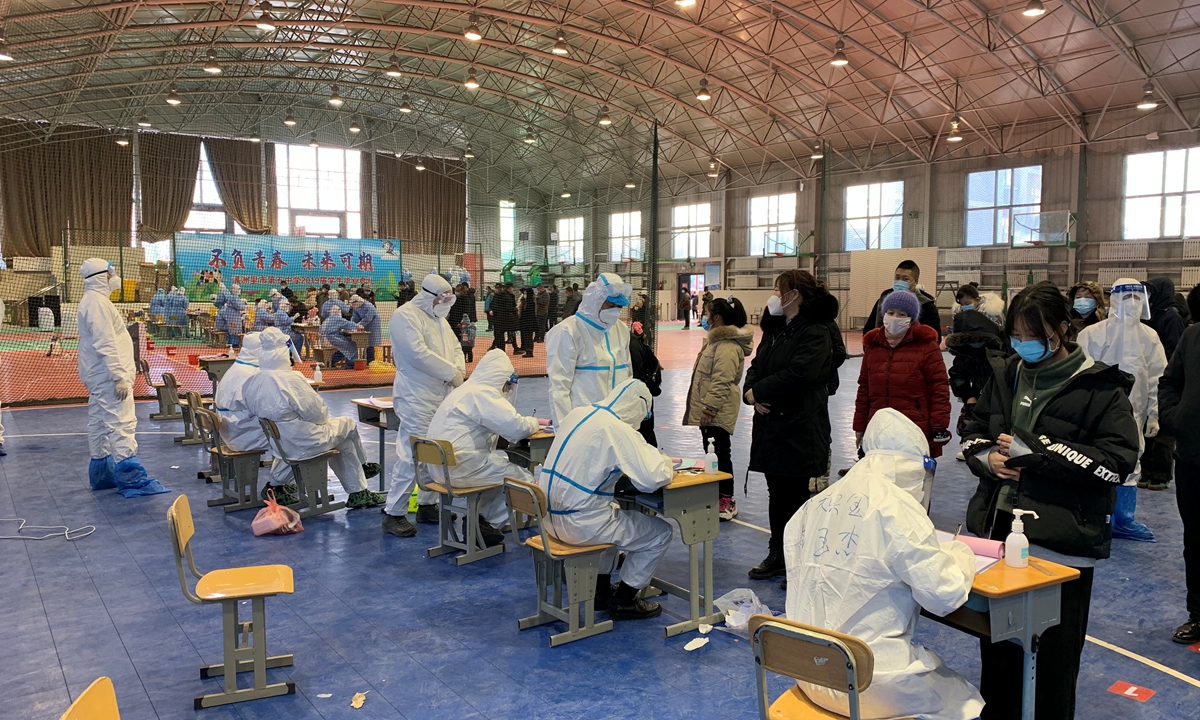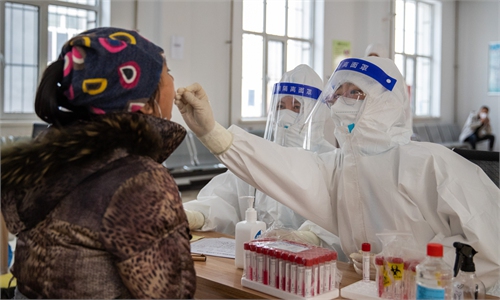N.China’s Manzhouli urged to plug epidemic prevention loopholes amid COVID-19 flare-ups

Residents in Manzhouli, North China's Inner Mongolia, are queuing for the second round of mass nucleic acid testing on November 29, 2021. Photo: CFP
A work group dispatched by the State Council has urged Manzhouli, a land port city in North China's Inner Mongolia - epicenter of this round of epidemic resurgence where 449 confirmed COVID-19 infections were registered - to further tighten up epidemic control measures and guard the gateway of the country.
Experts said that China's current aim is to manage clearing emerging COVID-19 infections when they occur, and once loopholes are detected should be timely plugged in to avoid further spread. They suggested that everyone in high risk of COVID-19 should heighten their daily personal protection so as to narrow the occurrence of loopholes.
Led by Wang Hesheng, a deputy head of National Health Commission and the head of National Bureau of Disease Control and Prevention, the group visited railway joint detection center, logistics companies, container handling station and e-port command center in Manzhouli to learn about their daily epidemic prevention and control measures.
The work group urged the city to investigate hidden loopholes and close loopholes, adopt a strict closed-loop management on people who deal with imported goods.
Manzhouli has become the epicenter of the fresh round of the epidemic flare-up. Since November 27, the virus starting from the city has now spread to at least four provincial regions, including Beijing, North China's Hebei and Northeast China's
Heilongjiang. Manzhouli carried out its 10th round of nucleic acid testing on Tuesday aiming to screen out more potential infections.
To plug loopholes, local authorities have updated their epidemic prevention and control measures, according to a draft document obtained by the Global Times.
The city has rolled out specific measures to manage epidemic prevention in closed-loop management zones, including the setup of containment, buffer and living zones, and have a clear boundary between port and urban areas. Employees who have higher risks will undergo tests every two days and must be fully vaccinated.
Previously, the Global Times learnt from people working at the port that due to extreme cold weather, some logistics companies within the port failed to implement closed-loop management properly. The first three positive cases in Manzhouli were detected among local companies at the port. Two were loaders and another was a wood-processing worker.
Trade activities and wood processing contribute a large part to Manzhouli's local economy and many enterprises are engaged in the wood processing industry. Freight trains carrying wood from overseas are shipped through the port.
Some local business representatives told with the Global Times that although authorities have implemented strict epidemic prevention measures among staff working at the port, including the freight train staff and those who work at warehouses, with regular nucleic acid testing requirement, there was still an absence of such requirement among workers at wood processing factories. This became the loopholes in the whole-process anti-epidemic work.
"It's very cold now in Manzhouli, with the temperatures sometimes reaching -20 C. The virus can survive on the surface of objects, for example, a piece of wood, for quite a long time. Also, the disinfectant does not work well when it's cold, as it turns into ice as soon as it is sprayed," a senior logistics firm manager who spoke on the condition of anonymity told the Global Times on Wednesday.
Also, as a major port connecting China with Central Asia and Europe, the Manzhouli port has been seen increasing passing freight volume since last year, which also added up the pressure of anti-epidemic work, some local business representatives said.
Public health experts reached by the Global Times also said the detection of a lot of new confirmed patients in the first few days demonstrated loopholes existed in Manzhouli's daily epidemic prevention and control measures. It also implies that COVID-19 had been spreading in the city for some time before it was discovered, the experts said.
The focus for China's epidemic prevention and control is "guard the gate and defend imported epidemic" amid the simmering epidemic infections, Vice Premier Sun Chunlan said at a virtual meeting of the joint prevention and control mechanism of the State Council on Tuesday.
China's prevention and control efforts have achieved maximum results at the lowest cost, effectively protecting people's lives and health as well as economic and social development. We must continue to insist on this policy and perseverance means victory, Sun said.
The epidemic in Manzhouli, East China's Nanjing and Southwest China's Yunnan Province have proved that loopholes will always exist in ports given their nature, where both people-to-people transmission and goods-to-people transmission are possible, experts noted.
Wang Guangfa, a respiratory expert at Peking University First Hospital, told the Global Times that China's dynamic zero-case policy is to manage clearing emerging COVID-19 infections when they occur, not to completely ward off new infections. While we manage to plug loopholes, we should face up to difficulties because when overseas epidemic is not over, chances for new epidemic flare-ups always exist.
There is always an occasional lapse in careful consideration. The essential to narrow the loopholes is to ask everyone who is in high risk of COVID-19 to do a good job in protecting themselves, washing hands and wearing masks, Wang said.



